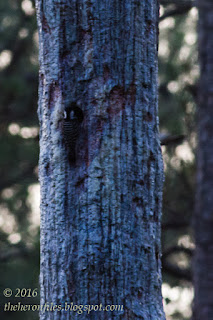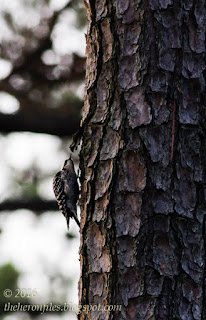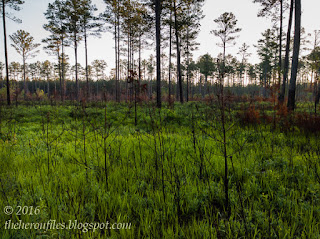Of course, it wasn't just any run-of-the-mill bird. It's the "near threatened" red-cockaded woodpecker and a lifer for both of us.
We joined a Virginia Society of Ornithology trip to Piney Grove Preserve in tidewater Virginia; about the only place to see them in the state. According to eBird there are have a few reported at other locations including a recently initiated population in the Great Dismal Swamp. But at Piney Grove they breed and the area is managed to provide the specific habitat that they require: older but living tall pine trees in an open, savanna area that experiences frequent fires. All of the known nesting locations are well recorded as is the breeding progress. So our guides, from the Nature Conservancy and the Center for Conservation Biology, led us directly to a nest that they knew would be busy. We arrived just as the sun started lightening up the sky and wandered through new undergrowth to get to a viewing site. The area was burned two months ago and was already showing significant regrowth.
On the walk over we flushed a nesting Towhee letting us get a quick look at four tiny eggs in a nest on the ground. This is where we were going to set up so we moved 100 ft further along so the bird could return.
The woodpeckers drill holes in live pines that are starting to suffer from a heartwood rot. They drill a hole into the center of the tree and then excavate a hole for the nest. They also drill small holes around the nest hole so that the side of the tree gets covered in sap. It is thought that this helps deter predators.
We watched the parents and helpers, non-breeding adults stay around and help out the dominant pair, bring food back to the nest several times.
We heard many other birds, like a bobwhite that called most of the time we were there, but only saw a few; like this summer tanager.
We then moved on to another site where we met a bird bander. He bands the birds when they are 6-10 days old. This helps the scientists track the birds as they move around and helps monitor numbers and genetic diversity. He had a light-wight ladder that he assembles as he climbs so he can climb up to the nest hole.
 |
| The ladder used to reach the nest is built piece by piece. |
 |
| You can just see the fledgling in his hand. |
He brought the three nestlings down to band them and we had the chance to see them. They are incredibly adorable.
At the last stop we saw a used turkey nest. There had been a burn 10 days ago and they saw the turkey on the nest so they cleared a fire line around the nest and protected it. By today the babies had hatched and left so there were only empty eggs left. You can see the burnt area in the upper right corner and the protected vegetation in the lower left.
All of this and we were back home before lunch. But a wonderful way to spend time with my wife. I'm sure we will have many more large and small adventures; many involving birds.








